Analyzing the Dynamic Tourism Environment: Trends, Risks and Impacts
VerifiedAdded on 2023/06/14
|19
|3268
|137
Report
AI Summary
This report provides a comprehensive analysis of the dynamic tourism environment, highlighting the key forces of change impacting the industry. It begins by defining tourism through triangulation, incorporating various perspectives to create a working definition. The report then delves into the historical development of tourism, examining the impact of significant global events such as global recessions and the FIFA World Cup. Furthermore, it explores contemporary risks identified in the World Economic Forum's Global Risk Report, focusing on unemployment and natural disasters, and their potential impact on tourism destinations locally, nationally, and globally. Finally, the report evaluates current trends identified in the ABTA Travel Trend Report, assessing their potential impact on specific sectors of the tourism industry, providing a holistic view of the challenges and opportunities facing the tourism sector today. Desklib provides a variety of solved assignments and past papers.
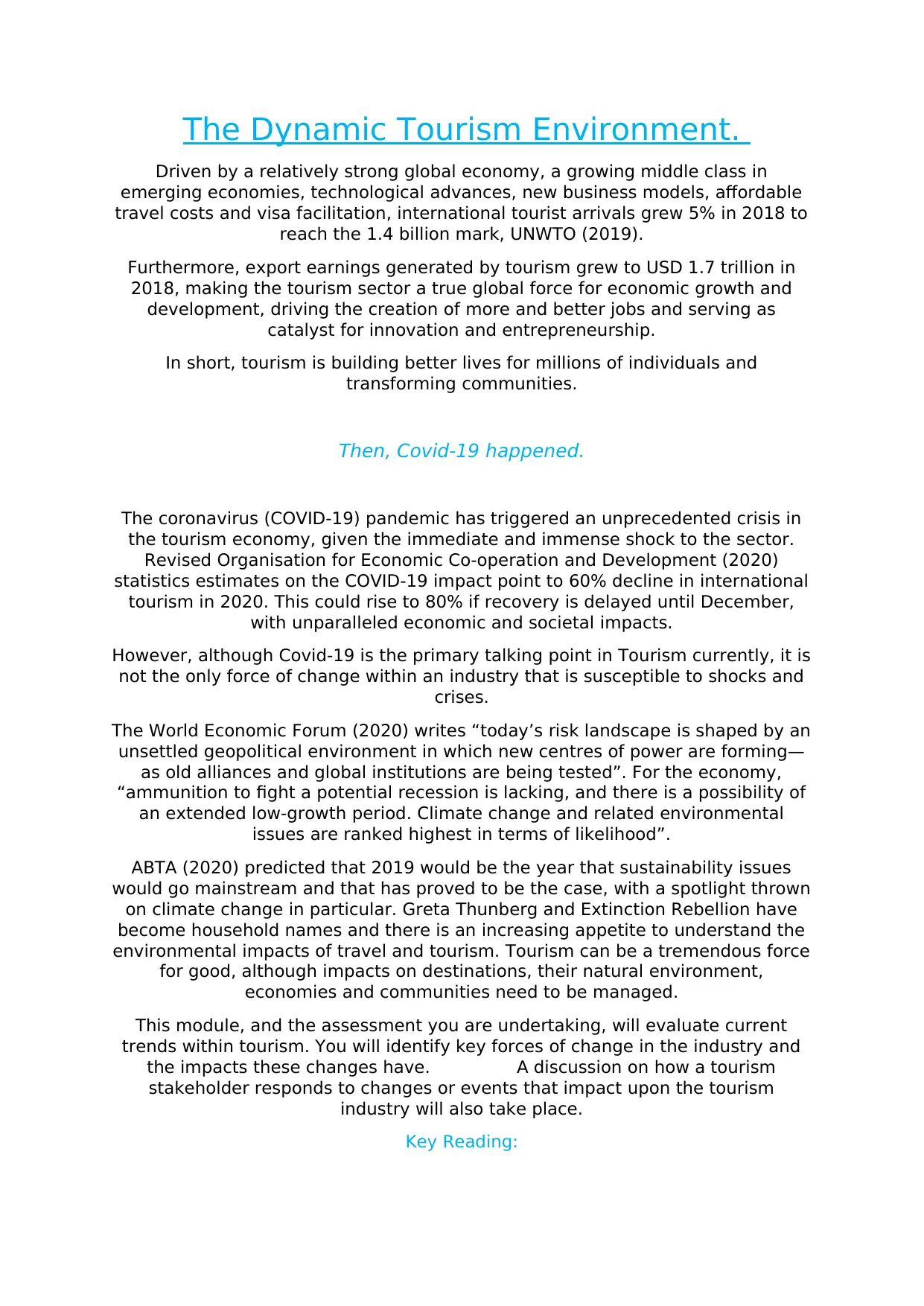
The Dynamic Tourism Environment.
Driven by a relatively strong global economy, a growing middle class in
emerging economies, technological advances, new business models, affordable
travel costs and visa facilitation, international tourist arrivals grew 5% in 2018 to
reach the 1.4 billion mark, UNWTO (2019).
Furthermore, export earnings generated by tourism grew to USD 1.7 trillion in
2018, making the tourism sector a true global force for economic growth and
development, driving the creation of more and better jobs and serving as
catalyst for innovation and entrepreneurship.
In short, tourism is building better lives for millions of individuals and
transforming communities.
Then, Covid-19 happened.
The coronavirus (COVID-19) pandemic has triggered an unprecedented crisis in
the tourism economy, given the immediate and immense shock to the sector.
Revised Organisation for Economic Co-operation and Development (2020)
statistics estimates on the COVID-19 impact point to 60% decline in international
tourism in 2020. This could rise to 80% if recovery is delayed until December,
with unparalleled economic and societal impacts.
However, although Covid-19 is the primary talking point in Tourism currently, it is
not the only force of change within an industry that is susceptible to shocks and
crises.
The World Economic Forum (2020) writes “today’s risk landscape is shaped by an
unsettled geopolitical environment in which new centres of power are forming—
as old alliances and global institutions are being tested”. For the economy,
“ammunition to fight a potential recession is lacking, and there is a possibility of
an extended low-growth period. Climate change and related environmental
issues are ranked highest in terms of likelihood”.
ABTA (2020) predicted that 2019 would be the year that sustainability issues
would go mainstream and that has proved to be the case, with a spotlight thrown
on climate change in particular. Greta Thunberg and Extinction Rebellion have
become household names and there is an increasing appetite to understand the
environmental impacts of travel and tourism. Tourism can be a tremendous force
for good, although impacts on destinations, their natural environment,
economies and communities need to be managed.
This module, and the assessment you are undertaking, will evaluate current
trends within tourism. You will identify key forces of change in the industry and
the impacts these changes have. A discussion on how a tourism
stakeholder responds to changes or events that impact upon the tourism
industry will also take place.
Key Reading:
Driven by a relatively strong global economy, a growing middle class in
emerging economies, technological advances, new business models, affordable
travel costs and visa facilitation, international tourist arrivals grew 5% in 2018 to
reach the 1.4 billion mark, UNWTO (2019).
Furthermore, export earnings generated by tourism grew to USD 1.7 trillion in
2018, making the tourism sector a true global force for economic growth and
development, driving the creation of more and better jobs and serving as
catalyst for innovation and entrepreneurship.
In short, tourism is building better lives for millions of individuals and
transforming communities.
Then, Covid-19 happened.
The coronavirus (COVID-19) pandemic has triggered an unprecedented crisis in
the tourism economy, given the immediate and immense shock to the sector.
Revised Organisation for Economic Co-operation and Development (2020)
statistics estimates on the COVID-19 impact point to 60% decline in international
tourism in 2020. This could rise to 80% if recovery is delayed until December,
with unparalleled economic and societal impacts.
However, although Covid-19 is the primary talking point in Tourism currently, it is
not the only force of change within an industry that is susceptible to shocks and
crises.
The World Economic Forum (2020) writes “today’s risk landscape is shaped by an
unsettled geopolitical environment in which new centres of power are forming—
as old alliances and global institutions are being tested”. For the economy,
“ammunition to fight a potential recession is lacking, and there is a possibility of
an extended low-growth period. Climate change and related environmental
issues are ranked highest in terms of likelihood”.
ABTA (2020) predicted that 2019 would be the year that sustainability issues
would go mainstream and that has proved to be the case, with a spotlight thrown
on climate change in particular. Greta Thunberg and Extinction Rebellion have
become household names and there is an increasing appetite to understand the
environmental impacts of travel and tourism. Tourism can be a tremendous force
for good, although impacts on destinations, their natural environment,
economies and communities need to be managed.
This module, and the assessment you are undertaking, will evaluate current
trends within tourism. You will identify key forces of change in the industry and
the impacts these changes have. A discussion on how a tourism
stakeholder responds to changes or events that impact upon the tourism
industry will also take place.
Key Reading:
Paraphrase This Document
Need a fresh take? Get an instant paraphrase of this document with our AI Paraphraser
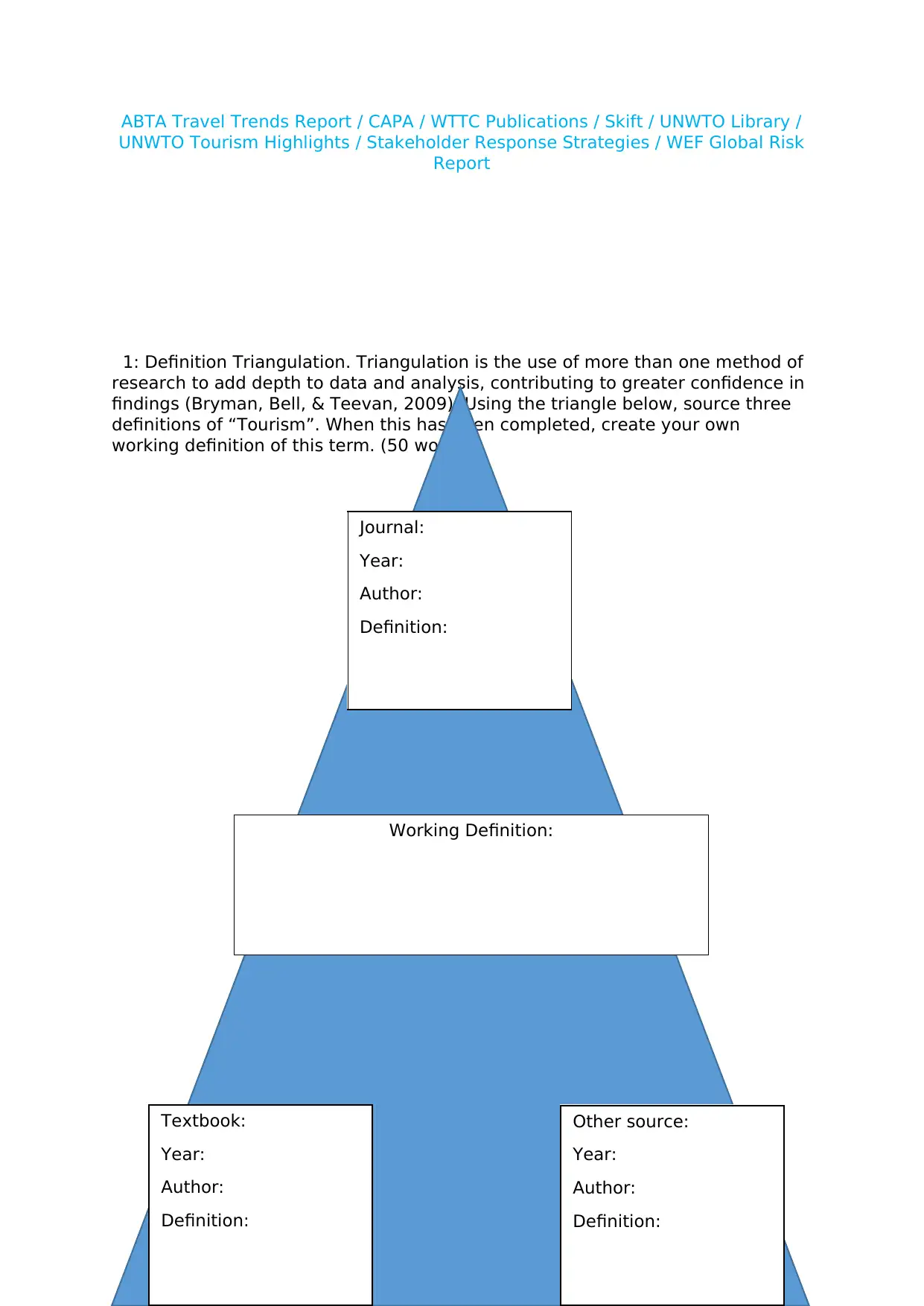
ABTA Travel Trends Report / CAPA / WTTC Publications / Skift / UNWTO Library /
UNWTO Tourism Highlights / Stakeholder Response Strategies / WEF Global Risk
Report
1: Definition Triangulation. Triangulation is the use of more than one method of
research to add depth to data and analysis, contributing to greater confidence in
findings (Bryman, Bell, & Teevan, 2009). Using the triangle below, source three
definitions of “Tourism”. When this has been completed, create your own
working definition of this term. (50 words).
Working Definition:
Textbook:
Year:
Author:
Definition:
Other source:
Year:
Author:
Definition:
Journal:
Year:
Author:
Definition:
UNWTO Tourism Highlights / Stakeholder Response Strategies / WEF Global Risk
Report
1: Definition Triangulation. Triangulation is the use of more than one method of
research to add depth to data and analysis, contributing to greater confidence in
findings (Bryman, Bell, & Teevan, 2009). Using the triangle below, source three
definitions of “Tourism”. When this has been completed, create your own
working definition of this term. (50 words).
Working Definition:
Textbook:
Year:
Author:
Definition:
Other source:
Year:
Author:
Definition:
Journal:
Year:
Author:
Definition:
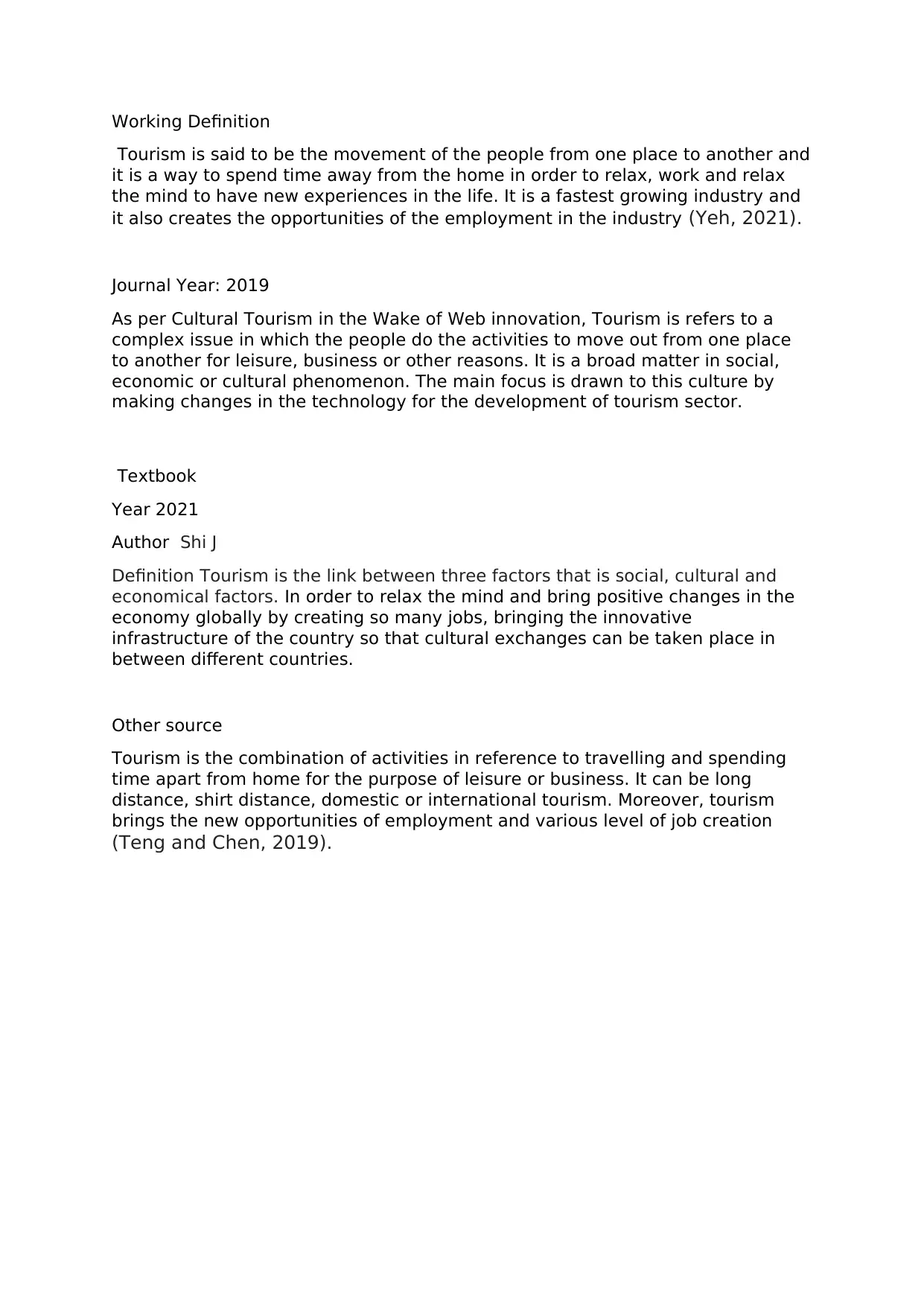
Working Definition
Tourism is said to be the movement of the people from one place to another and
it is a way to spend time away from the home in order to relax, work and relax
the mind to have new experiences in the life. It is a fastest growing industry and
it also creates the opportunities of the employment in the industry (Yeh, 2021).
Journal Year: 2019
As per Cultural Tourism in the Wake of Web innovation, Tourism is refers to a
complex issue in which the people do the activities to move out from one place
to another for leisure, business or other reasons. It is a broad matter in social,
economic or cultural phenomenon. The main focus is drawn to this culture by
making changes in the technology for the development of tourism sector.
Textbook
Year 2021
Author Shi J
Definition Tourism is the link between three factors that is social, cultural and
economical factors. In order to relax the mind and bring positive changes in the
economy globally by creating so many jobs, bringing the innovative
infrastructure of the country so that cultural exchanges can be taken place in
between different countries.
Other source
Tourism is the combination of activities in reference to travelling and spending
time apart from home for the purpose of leisure or business. It can be long
distance, shirt distance, domestic or international tourism. Moreover, tourism
brings the new opportunities of employment and various level of job creation
(Teng and Chen, 2019).
Tourism is said to be the movement of the people from one place to another and
it is a way to spend time away from the home in order to relax, work and relax
the mind to have new experiences in the life. It is a fastest growing industry and
it also creates the opportunities of the employment in the industry (Yeh, 2021).
Journal Year: 2019
As per Cultural Tourism in the Wake of Web innovation, Tourism is refers to a
complex issue in which the people do the activities to move out from one place
to another for leisure, business or other reasons. It is a broad matter in social,
economic or cultural phenomenon. The main focus is drawn to this culture by
making changes in the technology for the development of tourism sector.
Textbook
Year 2021
Author Shi J
Definition Tourism is the link between three factors that is social, cultural and
economical factors. In order to relax the mind and bring positive changes in the
economy globally by creating so many jobs, bringing the innovative
infrastructure of the country so that cultural exchanges can be taken place in
between different countries.
Other source
Tourism is the combination of activities in reference to travelling and spending
time apart from home for the purpose of leisure or business. It can be long
distance, shirt distance, domestic or international tourism. Moreover, tourism
brings the new opportunities of employment and various level of job creation
(Teng and Chen, 2019).
⊘ This is a preview!⊘
Do you want full access?
Subscribe today to unlock all pages.

Trusted by 1+ million students worldwide

Paraphrase This Document
Need a fresh take? Get an instant paraphrase of this document with our AI Paraphraser
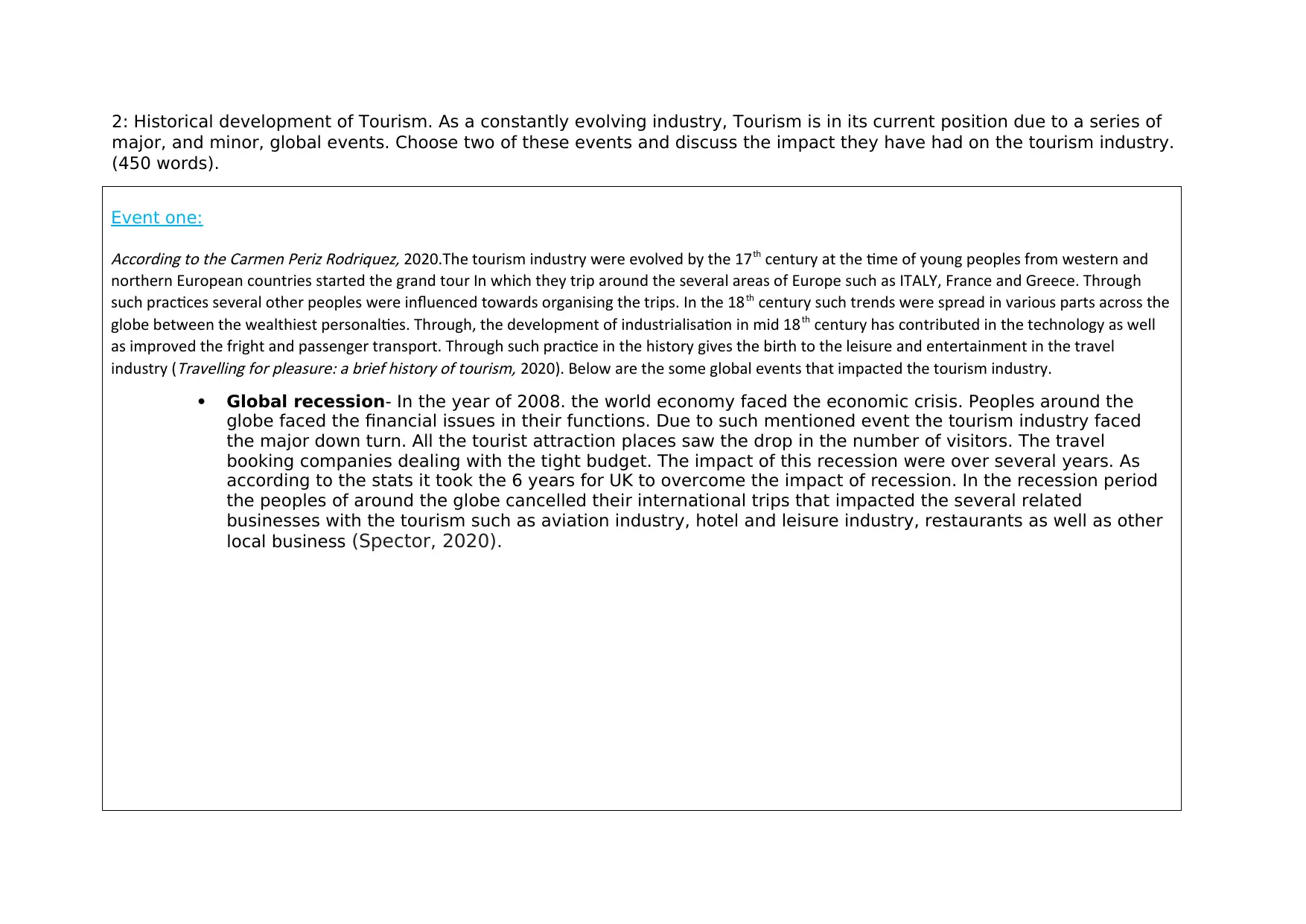
2: Historical development of Tourism. As a constantly evolving industry, Tourism is in its current position due to a series of
major, and minor, global events. Choose two of these events and discuss the impact they have had on the tourism industry.
(450 words).
Event one:
According to the Carmen Periz Rodriquez, 2020.The tourism industry were evolved by the 17th century at the time of young peoples from western and
northern European countries started the grand tour In which they trip around the several areas of Europe such as ITALY, France and Greece. Through
such practices several other peoples were influenced towards organising the trips. In the 18th century such trends were spread in various parts across the
globe between the wealthiest personalties. Through, the development of industrialisation in mid 18th century has contributed in the technology as well
as improved the fright and passenger transport. Through such practice in the history gives the birth to the leisure and entertainment in the travel
industry (
Travelling for pleasure: a brief history of tourism, 2020). Below are the some global events that impacted the tourism industry.
Global recession- In the year of 2008. the world economy faced the economic crisis. Peoples around the
globe faced the financial issues in their functions. Due to such mentioned event the tourism industry faced
the major down turn. All the tourist attraction places saw the drop in the number of visitors. The travel
booking companies dealing with the tight budget. The impact of this recession were over several years. As
according to the stats it took the 6 years for UK to overcome the impact of recession. In the recession period
the peoples of around the globe cancelled their international trips that impacted the several related
businesses with the tourism such as aviation industry, hotel and leisure industry, restaurants as well as other
local business (Spector, 2020).
major, and minor, global events. Choose two of these events and discuss the impact they have had on the tourism industry.
(450 words).
Event one:
According to the Carmen Periz Rodriquez, 2020.The tourism industry were evolved by the 17th century at the time of young peoples from western and
northern European countries started the grand tour In which they trip around the several areas of Europe such as ITALY, France and Greece. Through
such practices several other peoples were influenced towards organising the trips. In the 18th century such trends were spread in various parts across the
globe between the wealthiest personalties. Through, the development of industrialisation in mid 18th century has contributed in the technology as well
as improved the fright and passenger transport. Through such practice in the history gives the birth to the leisure and entertainment in the travel
industry (
Travelling for pleasure: a brief history of tourism, 2020). Below are the some global events that impacted the tourism industry.
Global recession- In the year of 2008. the world economy faced the economic crisis. Peoples around the
globe faced the financial issues in their functions. Due to such mentioned event the tourism industry faced
the major down turn. All the tourist attraction places saw the drop in the number of visitors. The travel
booking companies dealing with the tight budget. The impact of this recession were over several years. As
according to the stats it took the 6 years for UK to overcome the impact of recession. In the recession period
the peoples of around the globe cancelled their international trips that impacted the several related
businesses with the tourism such as aviation industry, hotel and leisure industry, restaurants as well as other
local business (Spector, 2020).
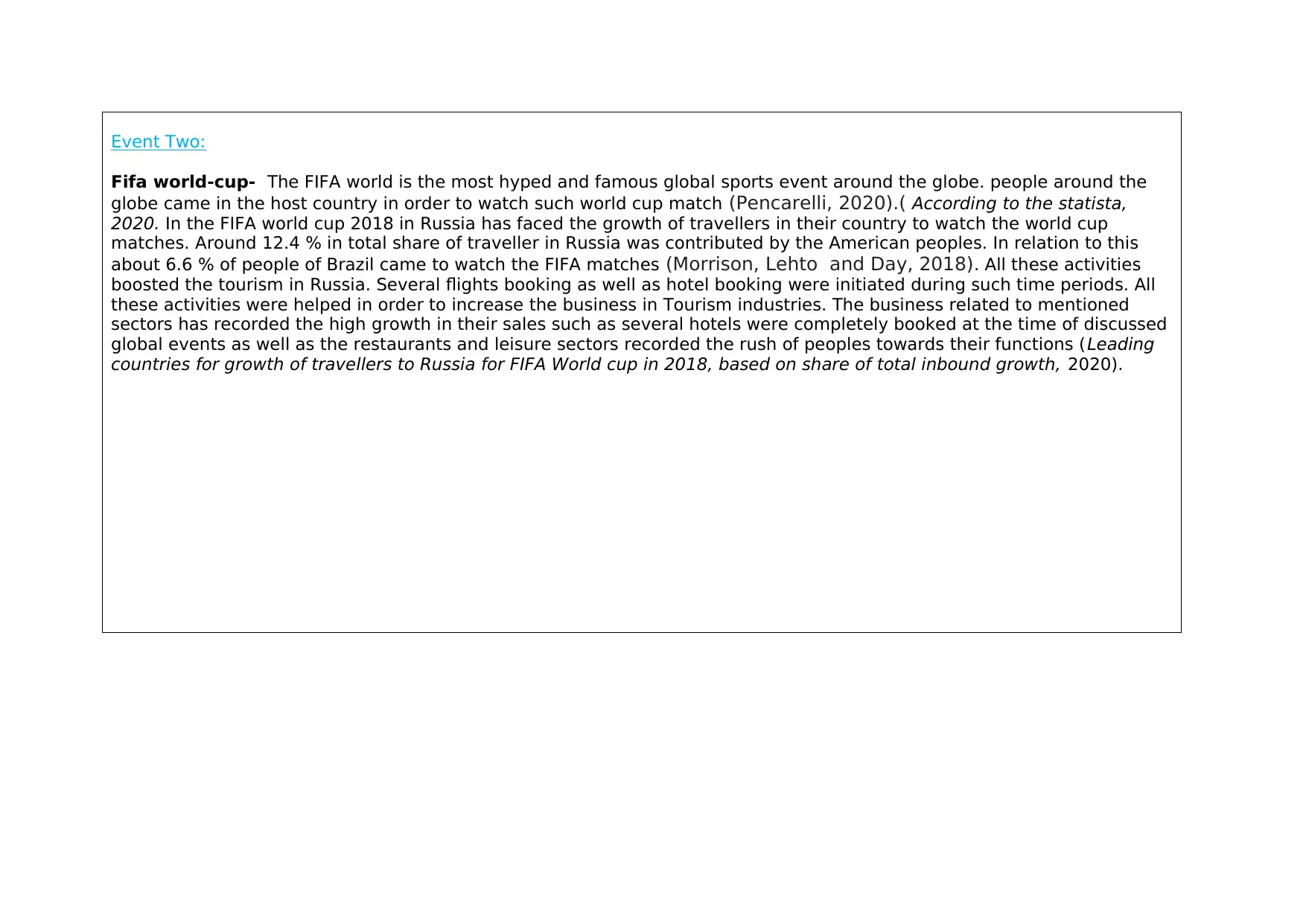
Event Two:
Fifa world-cup- The FIFA world is the most hyped and famous global sports event around the globe. people around the
globe came in the host country in order to watch such world cup match (Pencarelli, 2020).( According to the statista,
2020. In the FIFA world cup 2018 in Russia has faced the growth of travellers in their country to watch the world cup
matches. Around 12.4 % in total share of traveller in Russia was contributed by the American peoples. In relation to this
about 6.6 % of people of Brazil came to watch the FIFA matches (Morrison, Lehto and Day, 2018). All these activities
boosted the tourism in Russia. Several flights booking as well as hotel booking were initiated during such time periods. All
these activities were helped in order to increase the business in Tourism industries. The business related to mentioned
sectors has recorded the high growth in their sales such as several hotels were completely booked at the time of discussed
global events as well as the restaurants and leisure sectors recorded the rush of peoples towards their functions (Leading
countries for growth of travellers to Russia for FIFA World cup in 2018, based on share of total inbound growth, 2020).
Fifa world-cup- The FIFA world is the most hyped and famous global sports event around the globe. people around the
globe came in the host country in order to watch such world cup match (Pencarelli, 2020).( According to the statista,
2020. In the FIFA world cup 2018 in Russia has faced the growth of travellers in their country to watch the world cup
matches. Around 12.4 % in total share of traveller in Russia was contributed by the American peoples. In relation to this
about 6.6 % of people of Brazil came to watch the FIFA matches (Morrison, Lehto and Day, 2018). All these activities
boosted the tourism in Russia. Several flights booking as well as hotel booking were initiated during such time periods. All
these activities were helped in order to increase the business in Tourism industries. The business related to mentioned
sectors has recorded the high growth in their sales such as several hotels were completely booked at the time of discussed
global events as well as the restaurants and leisure sectors recorded the rush of peoples towards their functions (Leading
countries for growth of travellers to Russia for FIFA World cup in 2018, based on share of total inbound growth, 2020).
⊘ This is a preview!⊘
Do you want full access?
Subscribe today to unlock all pages.

Trusted by 1+ million students worldwide
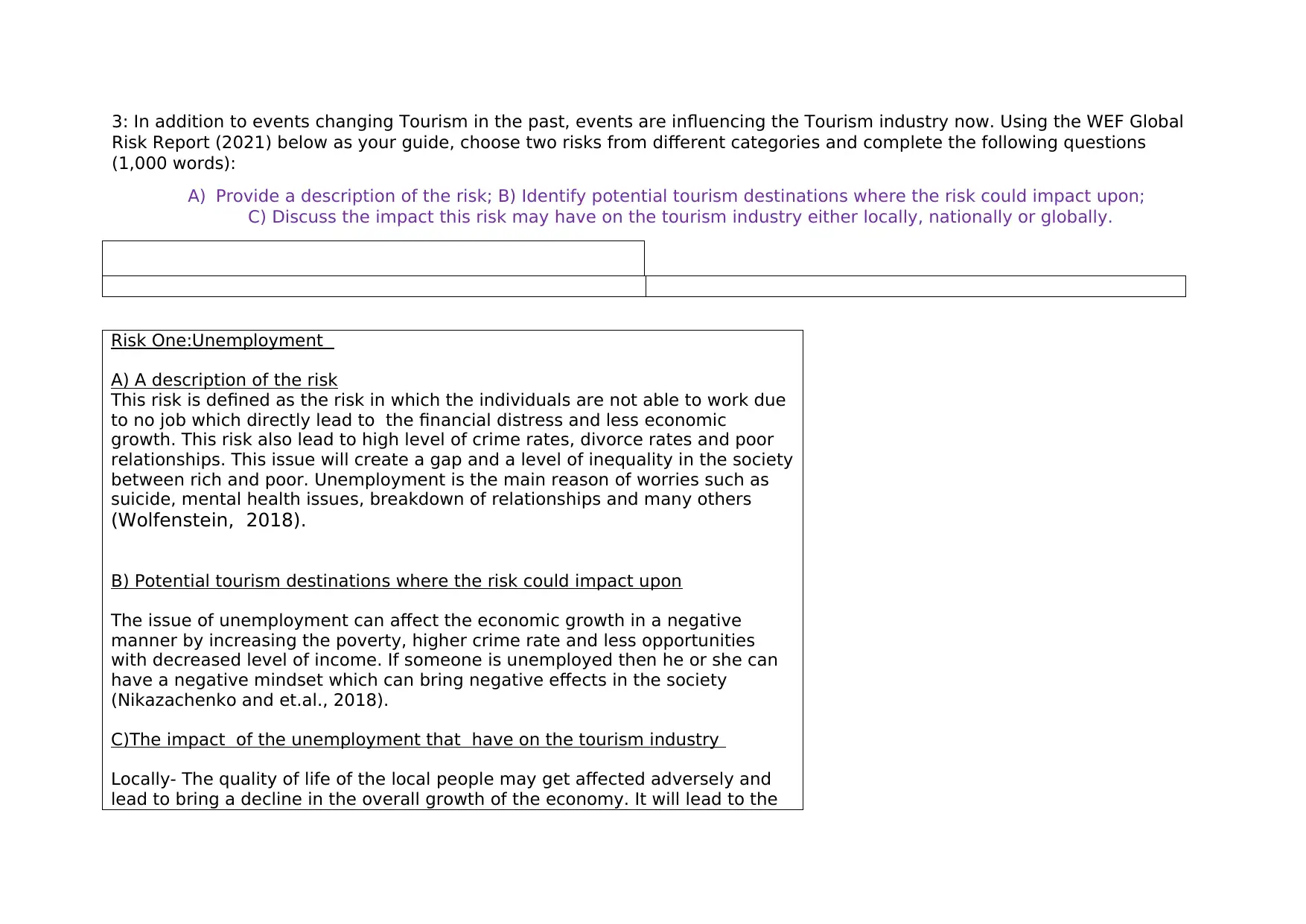
3: In addition to events changing Tourism in the past, events are influencing the Tourism industry now. Using the WEF Global
Risk Report (2021) below as your guide, choose two risks from different categories and complete the following questions
(1,000 words):
A) Provide a description of the risk; B) Identify potential tourism destinations where the risk could impact upon;
C) Discuss the impact this risk may have on the tourism industry either locally, nationally or globally.
Risk One:Unemployment
A) A description of the risk
This risk is defined as the risk in which the individuals are not able to work due
to no job which directly lead to the financial distress and less economic
growth. This risk also lead to high level of crime rates, divorce rates and poor
relationships. This issue will create a gap and a level of inequality in the society
between rich and poor. Unemployment is the main reason of worries such as
suicide, mental health issues, breakdown of relationships and many others
(Wolfenstein, 2018).
B) Potential tourism destinations where the risk could impact upon
The issue of unemployment can affect the economic growth in a negative
manner by increasing the poverty, higher crime rate and less opportunities
with decreased level of income. If someone is unemployed then he or she can
have a negative mindset which can bring negative effects in the society
(Nikazachenko and et.al., 2018).
C)The impact of the unemployment that have on the tourism industry
Locally- The quality of life of the local people may get affected adversely and
lead to bring a decline in the overall growth of the economy. It will lead to the
Risk Report (2021) below as your guide, choose two risks from different categories and complete the following questions
(1,000 words):
A) Provide a description of the risk; B) Identify potential tourism destinations where the risk could impact upon;
C) Discuss the impact this risk may have on the tourism industry either locally, nationally or globally.
Risk One:Unemployment
A) A description of the risk
This risk is defined as the risk in which the individuals are not able to work due
to no job which directly lead to the financial distress and less economic
growth. This risk also lead to high level of crime rates, divorce rates and poor
relationships. This issue will create a gap and a level of inequality in the society
between rich and poor. Unemployment is the main reason of worries such as
suicide, mental health issues, breakdown of relationships and many others
(Wolfenstein, 2018).
B) Potential tourism destinations where the risk could impact upon
The issue of unemployment can affect the economic growth in a negative
manner by increasing the poverty, higher crime rate and less opportunities
with decreased level of income. If someone is unemployed then he or she can
have a negative mindset which can bring negative effects in the society
(Nikazachenko and et.al., 2018).
C)The impact of the unemployment that have on the tourism industry
Locally- The quality of life of the local people may get affected adversely and
lead to bring a decline in the overall growth of the economy. It will lead to the
Paraphrase This Document
Need a fresh take? Get an instant paraphrase of this document with our AI Paraphraser
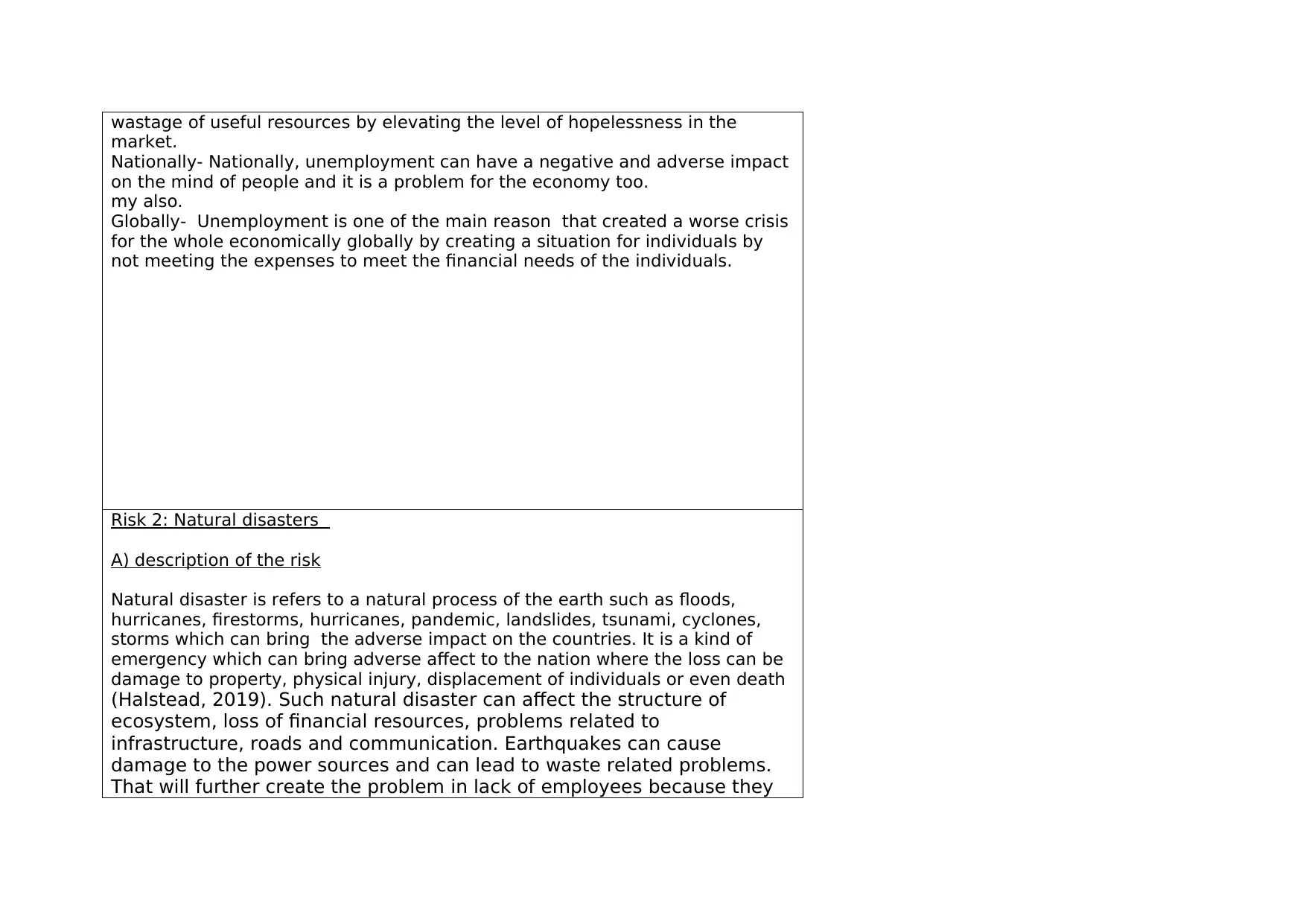
wastage of useful resources by elevating the level of hopelessness in the
market.
Nationally- Nationally, unemployment can have a negative and adverse impact
on the mind of people and it is a problem for the economy too.
my also.
Globally- Unemployment is one of the main reason that created a worse crisis
for the whole economically globally by creating a situation for individuals by
not meeting the expenses to meet the financial needs of the individuals.
Risk 2: Natural disasters
A) description of the risk
Natural disaster is refers to a natural process of the earth such as floods,
hurricanes, firestorms, hurricanes, pandemic, landslides, tsunami, cyclones,
storms which can bring the adverse impact on the countries. It is a kind of
emergency which can bring adverse affect to the nation where the loss can be
damage to property, physical injury, displacement of individuals or even death
(Halstead, 2019). Such natural disaster can affect the structure of
ecosystem, loss of financial resources, problems related to
infrastructure, roads and communication. Earthquakes can cause
damage to the power sources and can lead to waste related problems.
That will further create the problem in lack of employees because they
market.
Nationally- Nationally, unemployment can have a negative and adverse impact
on the mind of people and it is a problem for the economy too.
my also.
Globally- Unemployment is one of the main reason that created a worse crisis
for the whole economically globally by creating a situation for individuals by
not meeting the expenses to meet the financial needs of the individuals.
Risk 2: Natural disasters
A) description of the risk
Natural disaster is refers to a natural process of the earth such as floods,
hurricanes, firestorms, hurricanes, pandemic, landslides, tsunami, cyclones,
storms which can bring the adverse impact on the countries. It is a kind of
emergency which can bring adverse affect to the nation where the loss can be
damage to property, physical injury, displacement of individuals or even death
(Halstead, 2019). Such natural disaster can affect the structure of
ecosystem, loss of financial resources, problems related to
infrastructure, roads and communication. Earthquakes can cause
damage to the power sources and can lead to waste related problems.
That will further create the problem in lack of employees because they
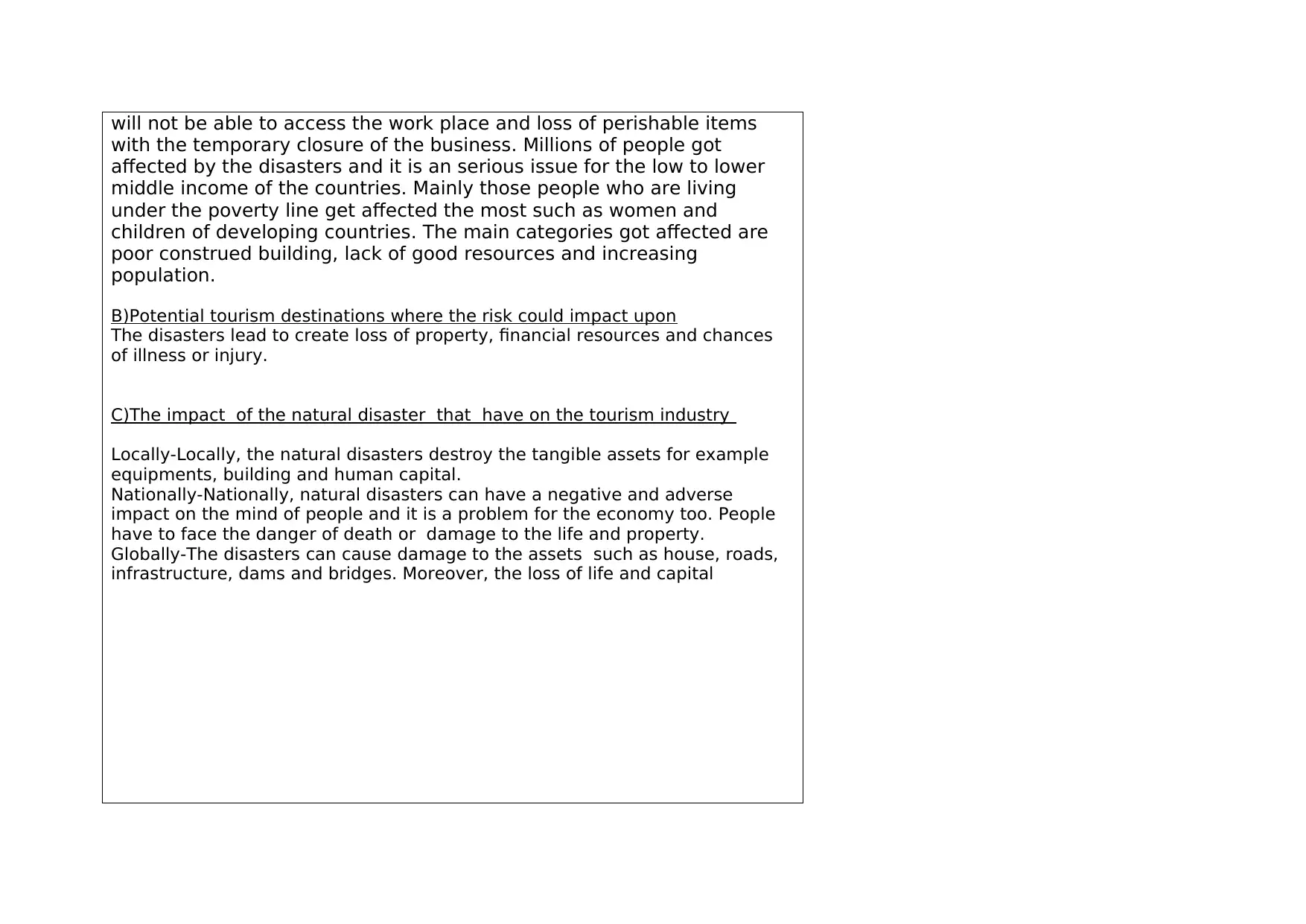
will not be able to access the work place and loss of perishable items
with the temporary closure of the business. Millions of people got
affected by the disasters and it is an serious issue for the low to lower
middle income of the countries. Mainly those people who are living
under the poverty line get affected the most such as women and
children of developing countries. The main categories got affected are
poor construed building, lack of good resources and increasing
population.
B)Potential tourism destinations where the risk could impact upon
The disasters lead to create loss of property, financial resources and chances
of illness or injury.
C)The impact of the natural disaster that have on the tourism industry
Locally-Locally, the natural disasters destroy the tangible assets for example
equipments, building and human capital.
Nationally-Nationally, natural disasters can have a negative and adverse
impact on the mind of people and it is a problem for the economy too. People
have to face the danger of death or damage to the life and property.
Globally-The disasters can cause damage to the assets such as house, roads,
infrastructure, dams and bridges. Moreover, the loss of life and capital
with the temporary closure of the business. Millions of people got
affected by the disasters and it is an serious issue for the low to lower
middle income of the countries. Mainly those people who are living
under the poverty line get affected the most such as women and
children of developing countries. The main categories got affected are
poor construed building, lack of good resources and increasing
population.
B)Potential tourism destinations where the risk could impact upon
The disasters lead to create loss of property, financial resources and chances
of illness or injury.
C)The impact of the natural disaster that have on the tourism industry
Locally-Locally, the natural disasters destroy the tangible assets for example
equipments, building and human capital.
Nationally-Nationally, natural disasters can have a negative and adverse
impact on the mind of people and it is a problem for the economy too. People
have to face the danger of death or damage to the life and property.
Globally-The disasters can cause damage to the assets such as house, roads,
infrastructure, dams and bridges. Moreover, the loss of life and capital
⊘ This is a preview!⊘
Do you want full access?
Subscribe today to unlock all pages.

Trusted by 1+ million students worldwide

Paraphrase This Document
Need a fresh take? Get an instant paraphrase of this document with our AI Paraphraser
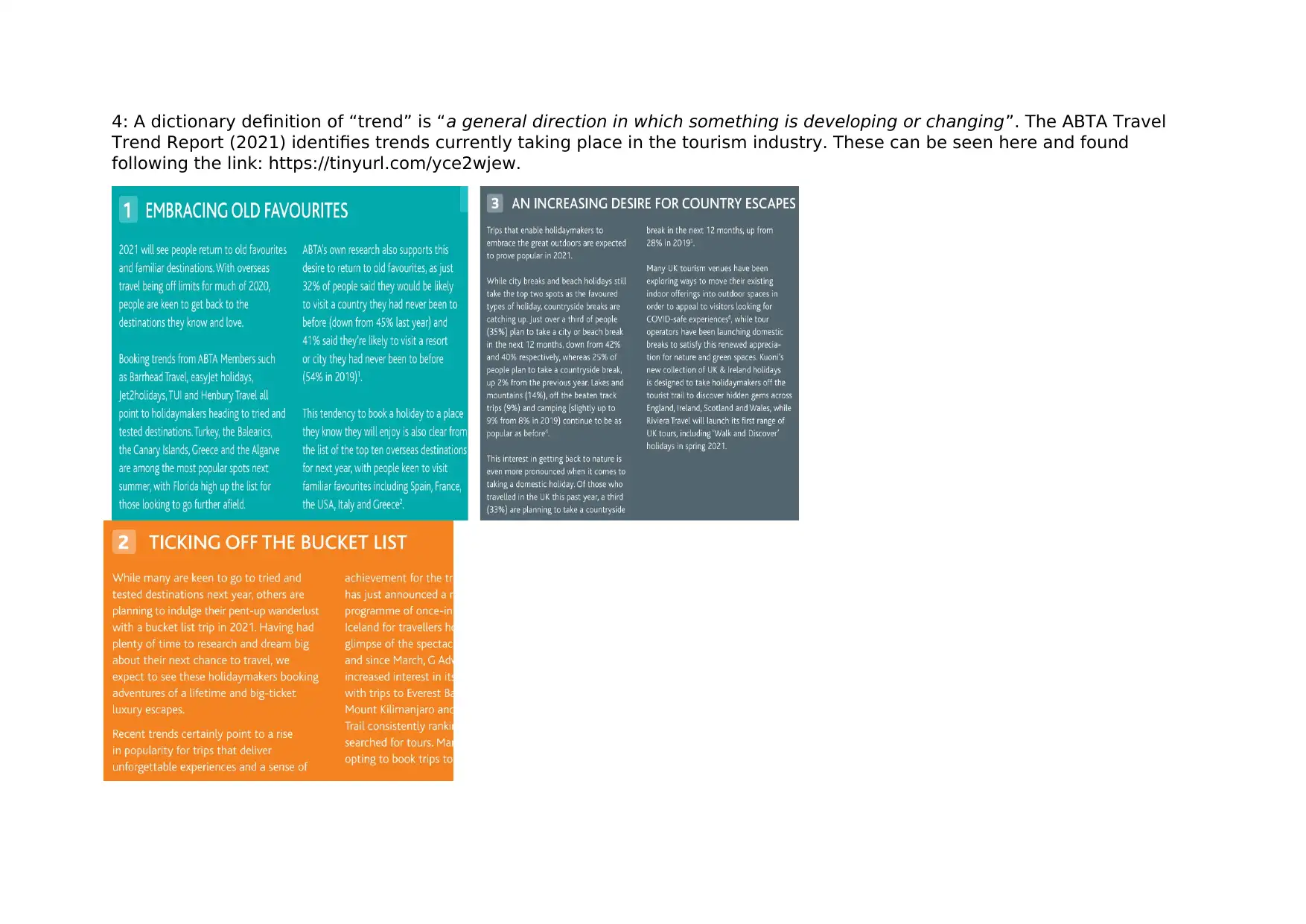
4: A dictionary definition of “trend” is “a general direction in which something is developing or changing”. The ABTA Travel
Trend Report (2021) identifies trends currently taking place in the tourism industry. These can be seen here and found
following the link: https://tinyurl.com/yce2wjew.
Trend Report (2021) identifies trends currently taking place in the tourism industry. These can be seen here and found
following the link: https://tinyurl.com/yce2wjew.
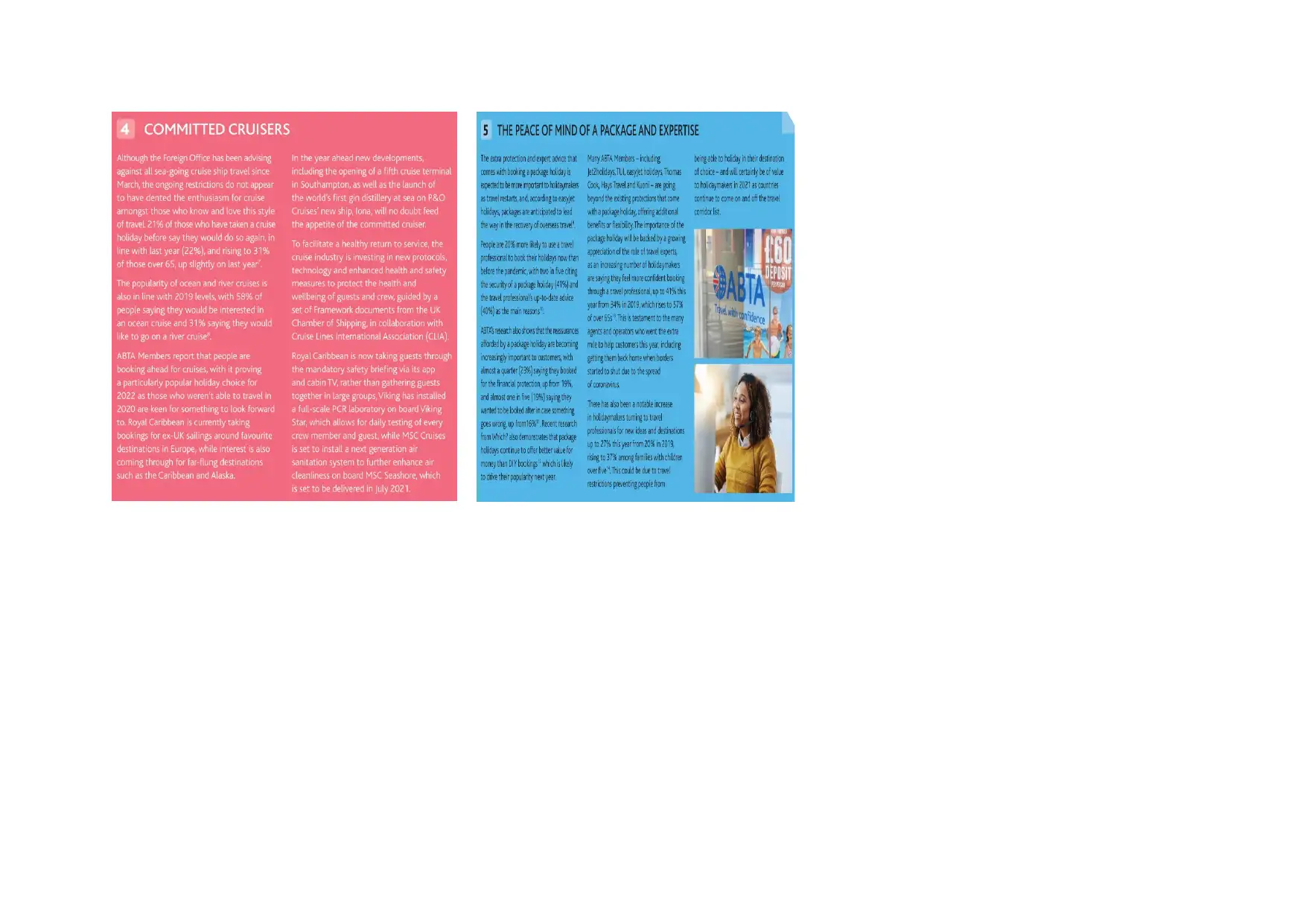
⊘ This is a preview!⊘
Do you want full access?
Subscribe today to unlock all pages.

Trusted by 1+ million students worldwide
1 out of 19
Related Documents
Your All-in-One AI-Powered Toolkit for Academic Success.
+13062052269
info@desklib.com
Available 24*7 on WhatsApp / Email
![[object Object]](/_next/static/media/star-bottom.7253800d.svg)
Unlock your academic potential
Copyright © 2020–2025 A2Z Services. All Rights Reserved. Developed and managed by ZUCOL.



